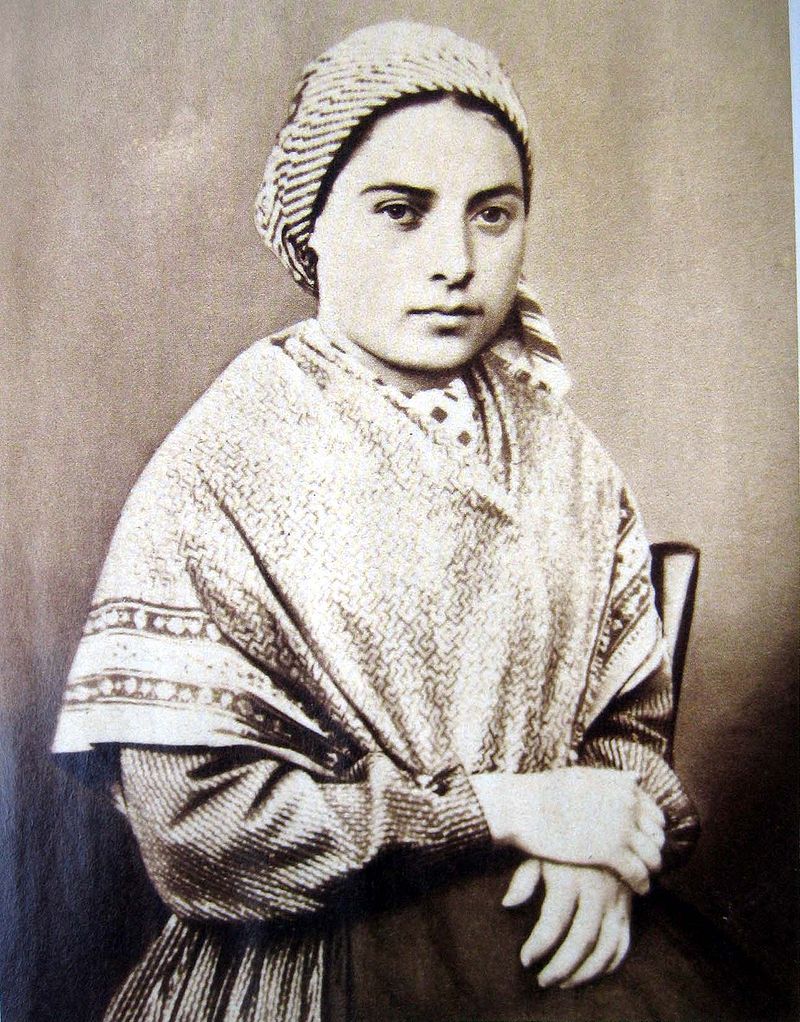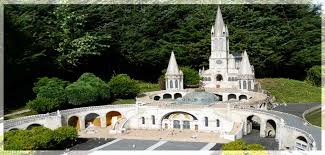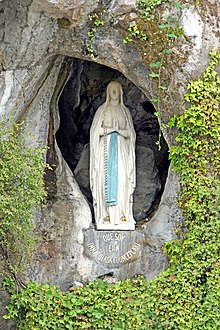






Bernadette Soubirous


In 1858, Bernadette Soubirous reported a vision of Our Lady of Lourdes. A simple 14-year-old peasant girl of no significant educational experience, Soubirous claimed she saw uo petito damizelo, "a small maiden," in white, with a golden rosary and blue belt fastened around her waist, and two golden roses at her feet. In subsequent visitations she heard the lady speak to her, saying Que soy era Immaculada Concepciou (I am the Immaculate Conception), and asking that a chapel be built there. At first ridiculed, questioned, and belittled by Church officials and other contemporaries, Soubirous insisted on her vision. Eventually the Church believed her and she was canonized by Pope Pius XI in 1933.
After church investigations confirmed her visions, a large church was built at the site. Lourdes is now a major Marian pilgrimage site: within France, only Paris has more hotels than Lourdes.
On 11 February 1858, Soubirous went with her sister Toinette and neighbor Jeanne Abadie to collect some firewood and bones in order to buy some bread. After taking off her shoes and stockings to wade through the water near the Grotto of Massabielle, she said she heard the sound of two gusts of wind (coups de vent) but the trees and bushes nearby did not move. A wild rose in a natural niche in the grotto, however, did move.
I came back towards the grotto and started taking off my stockings. I had hardly taken off the first stocking when I heard a sound like a gust of wind. Then I turned my head towards the meadow. I saw the trees quite still: I went on taking off my stockings. I heard the same sound again. As I raised my head to look at the grotto, I saw a lady dressed in white, wearing a white dress, a blue girdle and a yellow rose on each foot, the same color as the chain of her rosary; the beads of the rosary were white....From the niche, or rather the dark alcove behind it, came a dazzling light.
Soubirous tried to make the sign of the Cross but she could not, because her hands were trembling. The lady smiled, and invited Soubirous to pray the rosary with her. Soubirous tried to keep this a secret, but Toinette told her mother. After parental cross-examination, she and her sister received corporal punishment for their story.
Three days later, 14 February, Soubirous returned to the Grotto. She had brought holy water as a test that the apparition was not of evil origin/provenance: "The second time was the following Sunday. ... Then I started to throw holy water in her direction, and at the same time I said that if she came from God she was to stay, but if not, she must go. She started to smile, and bowed ... This was the second time.
Soubirous's companions are said to have become afraid when they saw her in ecstasy. She remained ecstatic even as they returned to the village. On 18 February, she spoke of being told by the Lady to return to the Grotto over a period of two weeks. She quoted the apparition: "The Lady only spoke to me the third time. ... She told me also that she did not promise to make me happy in this world, but in the next."
Soubirous was ordered by her parents to never go there again. She went anyway, and on 24 February, Soubirous related that the apparition asked for prayer and penitence for the conversion of sinners.
The next day, she said the apparition asked her to dig in the ground and drink from the spring she found there. This made her dishevelled and some of her supporters were dismayed, but this act revealed the stream that soon became a focal point for pilgrimages.Although it was muddy at first, the stream became increasingly clean. As word spread, this water was given to medical patients of all kinds, and many reports of miraculous cures followed. Seven of these cures were confirmed as lacking any medical explanations by Professor Verges in 1860. The first person with a "certified miracle" was a woman whose right hand had been deformed as a consequence of an accident. Several miracles turned out to be short-term improvement or even hoaxes, and Church and government officials became increasingly concerned.The government fenced off the Grotto and issued stiff penalties for anybody trying to get near the off-limits area. In the process, Lourdes became a national issue in France, resulting in the intervention of Emperor Napoleon III with an order to reopen the grotto on 4 October 1858. The Church had decided to stay away from the controversy altogether.
Soubirous, knowing the local area well, managed to visit the barricaded grotto under cover of darkness. There, on 25 March, she said she was told: "I am the Immaculate Conception" ("que soy era immaculada concepciou"). On Easter Sunday, 7 April, her examining doctor stated that Soubirous, in ecstasy, was observed to have held her hands over a lit candle without sustaining harm. On 16 July, Soubirous went for the last time to the Grotto. "I have never seen her so beautiful before,"she reported The Church, faced with nationwide questions, decided to institute an investigative commission on 17 November 1858. On 18 January 1860, the local bishop finally declared that: "The Virgin Mary did appear indeed to Bernadette Soubirous." These events established the Marian veneration in Lourdes, which together with Fátima, is one of the most frequented Marian shrines in the world, and to which between 4 and 6 million pilgrims travel annually.
In 1863, Joseph-Hugues Fabisch was charged to create a statue of the Virgin according to Soubirous's description. The work was placed in the grotto and solemnly dedicated on 4 April 1864 in presence of 20,000 pilgrims.
The veracity of the apparitions of Lourdes is not an article of faith for Catholics. Nevertheless, all recent Popes visited the Marian shrine at some time. Benedict XV, Pius XI, and John XXIII went there as bishops, Pius XII as papal delegate. He also issued an encyclical, Le pèlerinage de Lourdes, on the one-hundredth anniversary of the apparitions in 1958. John Paul II visited Lourdes three times during his Pontificate, and twice before as a Bishop.
Many Marian apparitions, although they may occur in different ages and cultures, share similarities. Soubirous's visions took place against a cultural backdrop of apparitions and other supernatural events that bear some resemblance to Soubirous's experiences. It is likely that Soubirous would have known of, and may even have been influenced by, such events, which were woven into the fabric of her society.
In nearby Lestelle-Bétharram, only a few kilometres from Lourdes, some shepherds guarding their flocks in the mountains observed a vision of a ray of light that guided them to the discovery of a statue of the Virgin Mary. Two attempts were made to remove the statue to a more prominent position; each time it disappeared and returned to its original location, at which a small chapel was built for it.
In the early sixteenth century, a twelve-year-old shepherdess called Anglèze de Sagazan received a vision of the Virgin Mary near the spring at Garaison (part of the commune of Monléon-Magnoac), somewhat further away. Anglèze's story is strikingly similar to that of Soubirous: she was a pious but illiterate and poorly educated girl, extremely impoverished, who spoke only in the local language, Gascon Occitan, but successfully convinced authorities that her vision was genuine and persuaded them to obey the instructions of her apparitions. Like Soubirous, she was the only one who could see the apparition (others could apparently hear it); however, the apparition at Garaison's supernatural powers tended toward the miraculous provision of abundant food, rather than healing the sick and injured. Mid-nineteenth century commentators noted the parallels between the events at Massabielle and Garaison, and interestingly, interpreted the similarities as proof of the divine nature of Soubirous's claims. At the time of Soubirous, Garaison was a noted center of pilgrimage and Marian devotion.
There are also several similarities between the apparition at La Salette, near Grenoble, and Lourdes. La Salette is many hundreds of kilometres from Lourdes, and the events at La Salette predate those in Lourdes by 12 years. However, Virgin Mary's appearance of La Salette was tall and maternal (not petite and gentle like her Lourdes apparition) and had a darker, more threatening series of messages. It is not certain if Soubirous was aware of the events at La Salette.
On 18 January 1862, Bishop Laurence, the Bishop of Tarbes, declared the following: "We are inspired by the Commission comprising wise, holy, learned and experienced priests who questioned the child, studied the facts, examined everything and weighed all the evidence. We have also called on science, and we remain convinced that the Apparitions are supernatural and divine, and that by consequence, what Soubirous saw was the Most Blessed Virgin. Our convictions are based on the testimony of Soubirous, but above all on the things that have happened, things which can be nothing other than divine intervention".